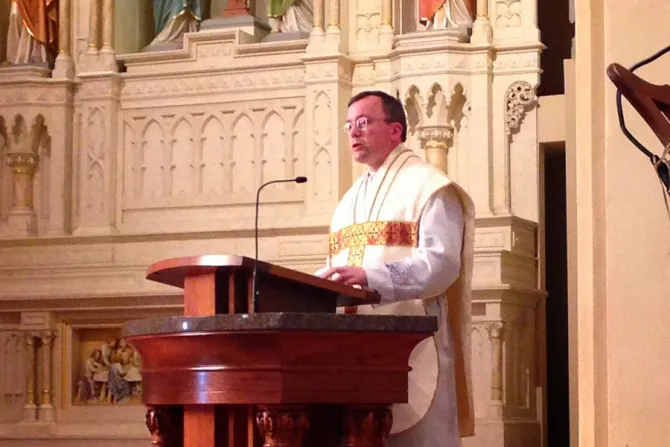Colorado Springs, Colorado, Oct 7, 2014 / 23:43 pm
A conference held last week in Colorado Springs by The Society for Catholic Liturgy brought together experts from multiple disciplines to discuss the continuity between the Jewish temple, and Catholic churches and liturgy.
Dr. Michael P. Foley, associate professor of patristics at Baylor University, is president of The Society for Catholic Liturgy. He told CNA at the closing of the Oct. 2-4 conference that the speakers "did a marvelous job connecting the dots" regarding its theme of "how the Christian church really is this fulfilment of the great Temple of Solomon."
"The society as a whole, I've always thought of as an enormously important organization because of the kinds of conversation that it generates. We get a really good interdisciplinary approach to things; there is a lot of talent that assembles – experts in art, architecture, music, and theology – and it's rare to get all those people in the same room … so it's nice to see the synergies that come together."
Foley added that the conferences of the Society for Catholic Liturgy, which publishes the journal Antiphon, are notable for their inclusion of both scholarly and pastoral presentations: "We don't want to be just some ivory tower, castle-in-the-air kind of organization, especially where the liturgy is concerned, because the liturgy … is about worship, which is active and practical. For it really to be a liturgical organization, we need to have both a scholarly and a pastoral side; I am pleased we have both those tracks."
The Oct. 2-4 conference, hosted by the Cathedral of St. Mary, included the celebration of Mass in both the ordinary and extraordinary forms, and of Vespers with Bishop Conley and with Bishop Michael Sheridan of Colorado Springs. It was among the best-attended annual conferences The Society for Catholic Liturgy has held, according to one of the group's board members.
The event began with Vespers and a keynote address by Bishop Conley, who called The Society for Catholic Liturgy "a true sign of hope" for the renewal of liturgy.
His keynote focused on the thesis that evangelization will be carried out by bringing beauty to Catholic culture and worship: "The ugliness of secularism demands that we proclaim the 'via pulchritudinis' [way of beauty] in the cathedrals and chapels and parish churches across the country," he said.
Bishop Conley asked those present to "imagine the transformation of our Church – of culture, in fact – if beautiful liturgy awakened Catholic souls to wonder, to conversion. Imagine the consequences of beautiful liturgy awakening souls to Jesus Christ."
He then offered three principles essential to promoting beauty in Catholic worship: gratitude, charity, and steadfast commitment.
Additional plenary addresses at the conference were given by Dr. Denis McNamara, an architect who spoke about how rediscovering the meaning of the Temple informs the design of Catholic churches; Duncan Stroik, also an architect, who spoke on renaissance-era churches as the fulfilment of Jewish Temple architecture; and Fr. Uwe Michael Lang, C.O., on the concept of sacrifice seen in St. Augustine's City of God and its link to the Eucharist.
McNamara showed that both Scripture and the Church fathers viewed church buildings as images of the Church herself, and that therefore "if you can say it about the mystical body (of Christ), you should be able to say it about the church building."
In addition to Church fathers and the Bible, he drew from such thinkers as Benedict XVI and Yves Congar, a leader of the ressourcement movement leading up to the Second Vatican Council. He also showed the potential for beautiful Church architecture in non-traditional manners, giving the example of a cathedral in Vietnam and Gaudi's Sagrada Familia in Barcelona.
Fr. Lang demonstrated that while St. Augustine's discussion of City of God X seems at first sight entirely interiorized and divorced from ritual, this is due to the apologetic nature of the text, and that the Bishop of Hippo obscured his otherwise Christocentric and Eucharistic understanding of sacrifice.
Among the many break-out sessions were those of Deacon David Lopez, chancellor of the Diocese of Sioux City, who discussed the importance of reclaiming the Levitical typology of the diaconate, saying that the loss of this understanding in recent decades "narrows our understanding of the diaconate and the way in which we understand the ministry of deacons as related to priests."
Nathan Knutson, director of sacred music at the Diocese of New Ulm, offered resources and processes for building a parish sacred music program, emphasizing the importance of prayer and of setting realistic goals.
Kyle Washut, an instructor at Wyoming Catholic College, spoke on the complementarity of St. Thomas Aquinas and St. Maximus the Confessor, important theologians of the Christian West and East, in their theologies of church architecture. Washut sees a fundamental harmony between the saints' approaches, and said that "because they're focused on the meaning of the Incarnation and its effect, both are able to break through the limitations of their traditions and answer the question of why we have a church building at all."
Further break-out sessions were offered by Bernard Brandt, J.D., who gave an introduction to the liturgical practice of the Byzantine rite, noting how that rite's worship is meant to involve the entirety of the human being.
Dr. Jennifer Donelson, a professor at Nova Southeastern University, discussed the importance of beauty and tradition in modernity, and for youth in particular. Donelson offered concrete considerations, in the areas of spirituality, liturgy, and artistry, for evaluating the appropriateness of particular works of music for inclusion in liturgical celebrations.
Dr. Anthony Lilles, academic dean of St. John's Seminary in Camarillo, spoke on the concept of Christians as temples of the Holy Spirit in the work of Blessed Elizabeth of the Trinity, a Carmelite nun and mystic who died at the age of 26.
The Society for Catholic Liturgy's next annual conference will be held in October 2015 in New York.



